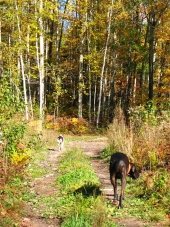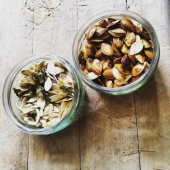Matu Collins wrote:The double fencing idea is very interesting. I've been planning a double fence design for a chicken moat, but a dog moat is also a good idea. We have a lot of whitetail deer here, and a double fence ismore effective than a single fence, and the fences don't need to be as high.
I'm just curious, what were chasing dogs bred to do and why did you choose them? And why so many?
Short version: They are all rescued strays. Most strays in Taiwan are Fomosa Black mixes probably because nothing else survives the streets or runs away from the dog catchers (the dog catchers in Taiwan wont chase dogs or pick up aggressive ones. They only catch and kill the nice ones that let themselves be taken). They are an old breed, brought here by aborignial Taiwanese people, presumably as hunting dogs. Today, some aboriginal people who live in the mountains will still hunt wild boar with them. The dogs chase and wear down the boar so that the people can (no joke) finish the boar with spears.
I said "chasing dogs" as just a way to describe their habits. They are all Formosa Black mixes that I rescued off the street. Almost all of the stray dogs in Taiwan are Formosa Black mutts. Not that there is alot of infomation of how they were bred or what they were bred to do, but the impression I am under is that they were brought over and informally bred by the Taiwanese aboriginal people. No dog shows or anything. Probably more along the lines of "this one didn't bite any children, and it has caught lots of boar so it gets to live (and breed)". Since Taiwan has been colonized by so many different peoples (the Dutch, Japanese and Chinese) who brought their own dogs with them, pure bred Formosa Blacks are rare and usually have genetic disorders from the shallow gene pool because there are so few.
Very few are kept as pets the way that mine are. Working Formosa Black mutts have one of two jobs: guarding and hunting large game. They make good guard dogs because they are extremely loyal. I say "extremely" because most absolutly will not tollerate strangers. This make them very difficult to rehome which is one of the reasons i have so many (we were originally a "foster home"). Some of them will even pick and choose "masters" within the house and avoid, bite or ignore other family members. Obviously, if you know how to train a dog properly, they wont bite or ignore family members, but we have one dog who loves my wife but avoids me when i don't have food or a leash. They are also used to hunt wild boar. When they bite, they don't latch on. They snap and then jump back. This makes them very capable of hunting dangerous game. They will hunt with a pack of dogs and their masters. When they catch a scent, they will chase it down, surround it, and wear it down (as oposed to latching on and triying to kill it). The tired boar is easier for the humans to catch up to and finish off with spears (the guns they are allowed to use in Taiwan are too weak to damage a boar through its thick skin).





 2
2




 1
1








 1
1




 1
1


























